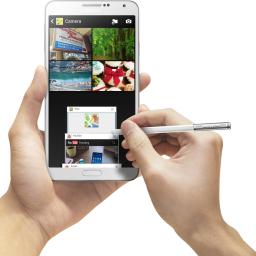
The
Samsung Galaxy Note 3 is probably the most well-known example of what we now call
phablets: half phone, half tablet. They're criticized for being too big to hold comfortably as a phone, too small to be a usable tablet with a screen large enough to watch media or read ebooks.
So why are they getting to be so popular? From Gigaom:
In less than three years, "phablets" have gone from a laughable name to the fastest growing handheld segment and they're not done yet. Look for nearly 200 million shipments this year alone as consumers see the value in a larger screen with voice capabilities. ... This year alone, [research firm IDC] thinks phablet shipments will rise 209.6 percent from last year alone with 174.9 million big-screened phones shipping in 2014. Part of this year's growth would be boosted by the introduction of a 5.5-inch Apple iPhone, widely expected to launch next week. In 2018, IDC figures 592.9 phablets will ship, accounting for 24.4 percent of all connected devices that year (connected devices include traditional smartphones, tablets, laptops and desktops).
[Ed. note: I've got the Note 3 and love it.]
Motorola used to be the powerhouse of mobile telephony. Now they're almost nobody. Their phones represent 2 percent of the global market for smartphones; Motorola Mobility lost $198 million in the first quarter of 2014, and its losses just since Google took over have totaled more than $1 billion, even as the company has cut some 17,000 workers.
ChicagoMag asks, "What the heck happened?" It's a hell of a story, and it's not over yet.
The history of many giant corporations (Lehman Brothers, General Motors) shows, great success can lead to great trouble. Interviews with key players in and around Motorola and its spinoffs indicate that the problems began when management jettisoned a powerful corporate culture that had been inculcated over decades. When healthy internal competition degenerated into damaging infighting. "I loved most of my time there," says Mike DiNanno, a former controller of several Motorola divisions, who worked at the company from 1984 to 2003. "But I hated the last few years."
Don't give up on Motorola yet! Their upcoming Moto 2 smartwatch looks phenomenal, and they've got new management and a couple of tricks up their sleeves. This article is a great chronicle of a company's demise, but skip down to the bottom for a glimpse of what's to come, too.
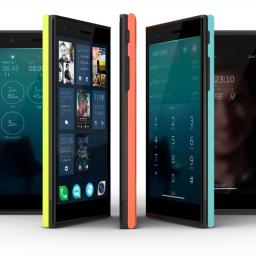
If you're tired of iOS, bored with Android, disgusted with Blackberry, and put off by Winphones, the folks over at Jolla would like to have a word with you.
Their Jolla phone, running a cutting-edge version of their Sailfish OS has just launched.If you hadn't heard, Jolla was founded by a bunch of ex-Nokia employees who decided to go solo with a Linux-based phone operating system when Nokia chose Elop and a Microsoft strategy. Will it work?
Having gone on retail sale at the end of 2013, it's been a busy and productive year for a company with an employee count that is in the low hundreds. Compare that to Microsoft, Apple, or Samsung, and you can put the success of the Jolla hardware and software into perspective. ...
The Jolla handset does not follow the normal paradigms for a smartphone user interface. As the smartphone moves away from the hackers and early supporters, improving the consumer experience has been one goal. The Sailfish UI is fast and flexible, and well-suited to one-handed usage. But it does take some getting used to. Jolla has improved the UI tutorial, and also added in dynamic hints and tips if the OS feels the user is 'stuck' looking for something in the UI.
The thing looks nice enough, but it's going to have to be slicker and sleeker than the existing alternatives to take traction. That said, there's no reason the market can be disrupted. Every time some pundit declares a winner, history proves them wrong.
Yes, it's another ZDNet "Six Clicks" (meaning six adverts) article, but I think it's worth it:
The six biggest smartphone flops over the past four years. Considering how far the technology - and Android in particular - has come, these are interesting phones that promised something new and alternative and then disappeared from the market months later. In five cases it was because the market just didn't want it; in one case it's because new leadership arrived and started slaying vampires.
Says author Matthew Miller:
Recent data shows that businesses are readily adopting iOS over other mobile operating systems. As we look at these smartphone failures, we see that Apple's iOS is a safe bet with well-supported devices and a rather consistent, progressive mobile strategy where experimental devices and strategies are not launched and then killed just a few months later. ... I have a feeling the Amazon Fire phone will soon be joining this list.
What's next? In a world of basically iOS and Android, what do you have to do to improve the user experience or differentiate your product?
[Ed. note: I agree about the Fire phone.]
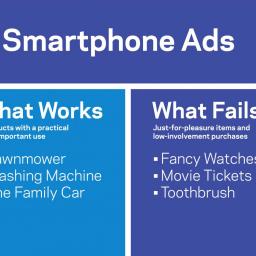
Columbia University researchers
have just published a study into the effectiveness of mobile adverts and come to some conclusions that may bode well for people who worry their smartphones will someday be yet another vector for annoying marketing. Turns out, adverts for many products are ineffective on mobile devices.
MDA campaigns that ran between 2007 and 2010 and involved 39,946 consumers show that MDA campaigns significantly increased consumers' favorable attitudes and purchase intentions only when the campaigns advertised products that were higher (vs. lower) involvement and utilitarian (vs. hedonic).
They are most effective when a product is either practical or are something that takes thought and investigation before making a purchase. Furthermore:
- Mobile ads do work for products that have a practical and important use, like a lawn mower or a washing machine
- Mobile ads do work for high-involvement products (a lot of time, thought and energy is placed into the decision, like a family car).
- Mobile ads don't work for just-for-pleasure items, like fancy watches
- Mobile ads don't work for low-involvement purchases like movie tickets or toothbrush (ones that pose a low risk to the buyer)
The study's abstract is available here.
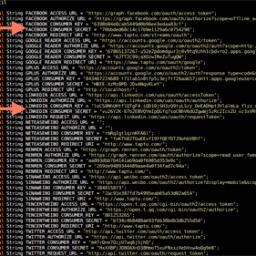
This story comes from CNet, who has dumbed the story down in a way that makes it a bit hard to understand [ed note: ironic]. But it appears
security researchers have reverse engineered over 880,000 of the Android app store's 1.1M free apps, and found a number of important security concerns .
The first concern is the existence of hard coded keys, which the article claims "username and password data -- which can then be used to steal user data or resources from entities such as Amazon and Facebook." That's not well explained, but that's CNet for you.
The second concern isn't so much a security issue as further evidence that the Android app store could use some better curating: the researchers discovered that roughly 25% of Android free apps are simply clones of other apps.
The researchers used a tool called "PlayDrone" which circumvents the App store's procedures to download apps and reverse engineer them to acquire source code.
The source article at Columbia University is better , or
PlayDrone yourself over at Github. A bit of nice work by researchers Jason Nieh and Nicolas Viennot.
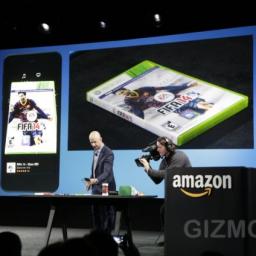
Today, Amazon revealed the
Fire Phone , its new Amazon branded phone. The device sports a quad-core 2.2GHz processor, 2GB of RAM, 32GB or 64GB storage, and a 13MP back-facing camera. Although the 4.7 inch screen is not actually 3D, a matrix of four front-facing cameras track your movements to alter your prospective.
What makes this an Amazon phone and not just another Android phone? Well, for starters, there is a dedicated hardware button to launch
Firefly - Amazon's version of Eden-of-the-East - that can snap a picture and identify nearly any product and then link to the Amazon page. In short, it makes it really easy to buy things on Amazon. Also, Amazon is offering
unlimited photo storage in the cloud. Together with Amazon Prime's new streaming video and music features, they seem to be really pushing the "Everything to the cloud!" approach.
WebOS is a mobile operating system developed by Palm in the last years before its collapse. It was sold to HP, who did very little with it. And despite a lot of rabid fans of the software, most people would tell you it was abandoned as iOS and Android swept the market. Instead, it was
sold to LG .
Smart Company reports
Palm's WebOS rides again as the software interface to a new wave of LG smart TVs . Over a million units have been sold so far, and LG research shows the market is in favor of the approach.
In-kyu Lee, vice president and head of LG Electronics' TV division, says the choice of webOS was driven by a choice of simplicity over "continuing to add more and more functions into our smart TVs that few people will ever use. Consumers seem to share our view that this is the right direction for the evolution of smart TVs going forward," Lee says.
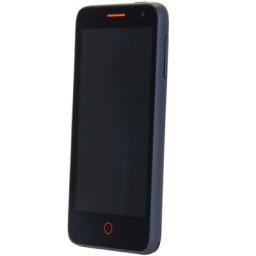
The Firefox OS reference device,
the Flame is now available for
pre-order for $170.
To standardize the design, development, and testing of Firefox OS, Mozilla has partnered with a company called T2Mobile to manufacture, distribute, and update a Firefox OS reference phone called the Flame. Until now, there has been no "reference device" and the options for getting something through retail were limited.
The Flame will also be a great development and testing environment for third party app developers targeting Firefox OS and HTML5.
Specifications:
- 1.2 Ghz Dual core processor (Qualcomm MSM8210 Snapdragon)
- 1 GB RAM
- 4.5" screen (854i-480)
- 5 MP rear camera, 2 MP front camera
- 8 GB storage, MicroSD slot
- GPS, NFC
- WiFi: 802.11 b/g/n, Bluetooth 3.0, Micro USB

Is wearable tech the next big thing, or has it already come and gone? Either way, it's the hot topic of 2014.
Blame Google, whose
Google Glass eyewear got everyone excited about something newer and trendier than an expensive smart phone (and made at least some people into instant
glassholes ), or blame Samsung's
Galaxy Gear watch, the
Pebble , and the
Nike Fuelband . It's easy to believe wearable computing is the
next wave of tech innovation. If so, we're not quite there yet, judging by reviews of current products. In fact, some pundits believe innovation is already beginning to
run out of steam .
Wearable tech is being attacked from all angles. While the techies wonder if Google Glass can
pass the ACID test , everyone else is just having enormous amounts of fun
parodying what a family full of wearable computer users might actually look like.
 The Samsung Galaxy Note 3 is probably the most well-known example of what we now call phablets: half phone, half tablet. They're criticized for being too big to hold comfortably as a phone, too small to be a usable tablet with a screen large enough to watch media or read ebooks.
The Samsung Galaxy Note 3 is probably the most well-known example of what we now call phablets: half phone, half tablet. They're criticized for being too big to hold comfortably as a phone, too small to be a usable tablet with a screen large enough to watch media or read ebooks.




